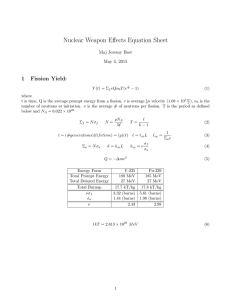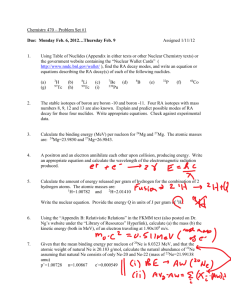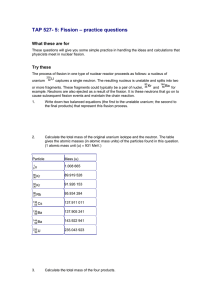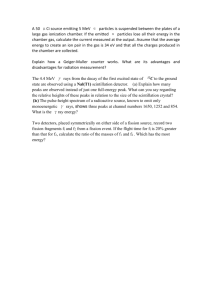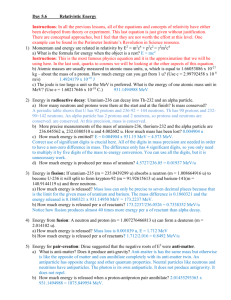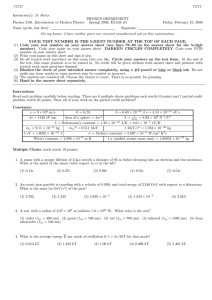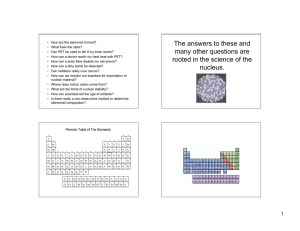Relativistic Energy
advertisement
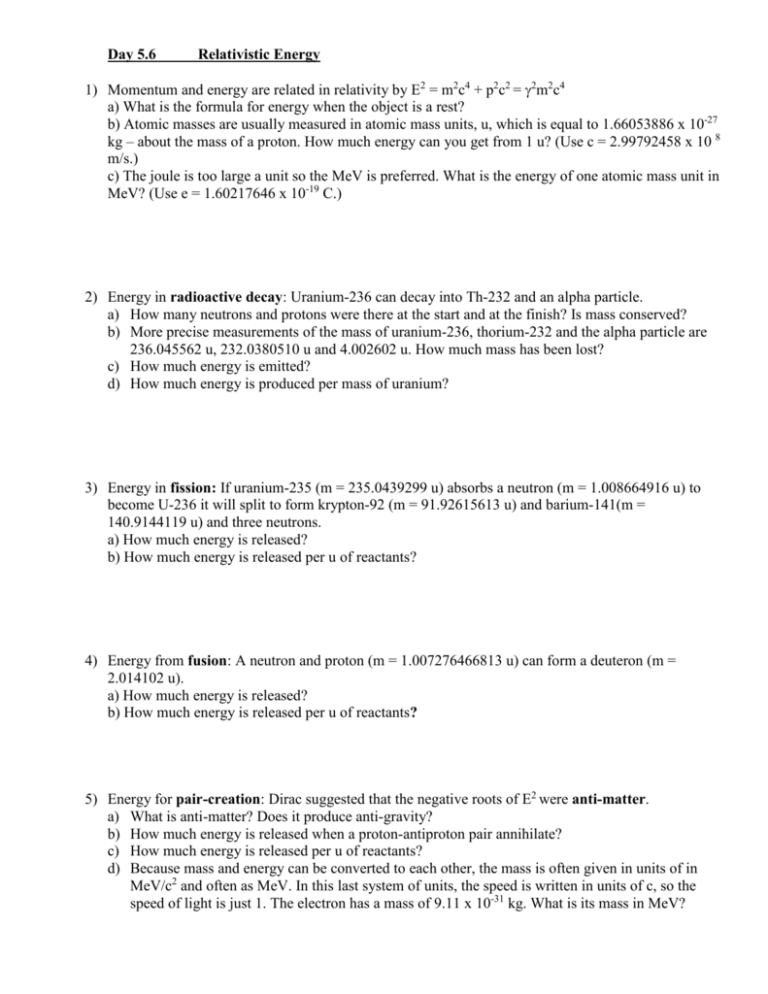
Day 5.6 Relativistic Energy 1) Momentum and energy are related in relativity by E2 = m2c4 + p2c2 = 2m2c4 a) What is the formula for energy when the object is a rest? b) Atomic masses are usually measured in atomic mass units, u, which is equal to 1.66053886 x 10-27 kg – about the mass of a proton. How much energy can you get from 1 u? (Use c = 2.99792458 x 10 8 m/s.) c) The joule is too large a unit so the MeV is preferred. What is the energy of one atomic mass unit in MeV? (Use e = 1.60217646 x 10-19 C.) 2) Energy in radioactive decay: Uranium-236 can decay into Th-232 and an alpha particle. a) How many neutrons and protons were there at the start and at the finish? Is mass conserved? b) More precise measurements of the mass of uranium-236, thorium-232 and the alpha particle are 236.045562 u, 232.0380510 u and 4.002602 u. How much mass has been lost? c) How much energy is emitted? d) How much energy is produced per mass of uranium? 3) Energy in fission: If uranium-235 (m = 235.0439299 u) absorbs a neutron (m = 1.008664916 u) to become U-236 it will split to form krypton-92 (m = 91.92615613 u) and barium-141(m = 140.9144119 u) and three neutrons. a) How much energy is released? b) How much energy is released per u of reactants? 4) Energy from fusion: A neutron and proton (m = 1.007276466813 u) can form a deuteron (m = 2.014102 u). a) How much energy is released? b) How much energy is released per u of reactants? 5) Energy for pair-creation: Dirac suggested that the negative roots of E2 were anti-matter. a) What is anti-matter? Does it produce anti-gravity? b) How much energy is released when a proton-antiproton pair annihilate? c) How much energy is released per u of reactants? d) Because mass and energy can be converted to each other, the mass is often given in units of in MeV/c2 and often as MeV. In this last system of units, the speed is written in units of c, so the speed of light is just 1. The electron has a mass of 9.11 x 10-31 kg. What is its mass in MeV? 6) Energy in pair-annihilation: Watch http://www.triumf.ca/videos/life-sciences (4.24 minutes) a) Where do the positrons and electrons in PET come from? b) Why are two photons emitted instead of one? c) How do the photons provide an image? d) Why is the F-18 attached to different molecules? e) What is the frequency of the photons emitted? What colour is this light? 7) In chemistry, you learn that mass is conserved in a chemical reaction. Is it? 8) This mass-energy conversion occurs in variety of places. Which type keeps the Earth’s core molten (___________________), powers the stars (___________________), was used in WWII (___________________), is used in H bombs (___________________), is used for nuclear power generation (___________________), is used for PET (___________________) scans, is used to hunt for the Higgs boson (___________________)? 9) Compare the conversion of mass to energy for decay, fission and fusion. Why is fusion used for the most powerful bombs but fission is used for energy generation? What has the potential to be the best fuel for space travel? 10) All the previous examples looked at particles at rest, where E = mc2. This question looks at moving particles. How much work must be done to get an object of mass m to a speed of 3/5 c? a) non-relativistically b) relativistically c) Why can’t a particle with mass go at the speed of light? d) For small speeds, v << c, it can be shown using the first two terms of the binomial expansion that ~ (1 + ½ v2/c2). What is the approximation for the energy of an object at small speeds? e) Light has no mass. Use the energy equation to show that it has momentum. 11) Go to Sixty Symbols: E = mc2. http://www.sixtysymbols.com/videos/emc2.htm (1:58-5:05) and Minute Physics: E = mc2 is incomplete http://www.youtube.com/watch?v=NnMIhxWRGNw Summarize their arguments about what important concepts are missed by E = mc2? 12) How does relativity affect the possibility of space travel? Consider t, d, v, m and E. Textbook: 11.3 p. 583 #1-6
